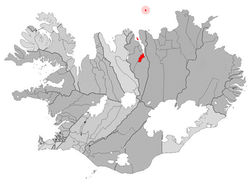
Back Akureyri Afrikaans Akureyri AN Æcerōratūn ANG أكوريري Arabic اكوريرى ARZ Akureyri AST Akureyri AVK Aküreyri Azerbaijani Акюрейри Bashkir Акурэйры Byelorussian
Akureyri | |
|---|---|
 An aerial view of downtown Akureyri | |
| Nickname: "Capital of North Iceland"[1] | |
 Location of the Akureyri Municipality | |
| Country | Iceland |
| Region | Northeastern Region |
| Constituency | Northeast Constituency |
| Government | |
| • Mayor | Ásthildur Sturludóttir |
| Area | |
• Total | 138 km2 (53 sq mi) |
| Population (2021)[2] | |
• Total | 19,219 |
| • Density | 131.82/km2 (341.4/sq mi) |
| Postal code(s) | 600, 601, 602, 603, 611, 630 |
| Municipal number | 6000 |
| Website | akureyri |
Akureyri (Icelandic pronunciation: [ˈaːkʏrˌeiːrɪ], locally [ˈaːkʰʏrˌeiːrɪ] ⓘ) is a town in northern Iceland, the country's fifth most populous municipality (under the official name of Akureyrarbær [-ˌeiːrarˌpaiːr̥], 'town of Akureyri') and the largest outside the Capital Region. The municipality includes the town's neighbourhood at the head of Eyjafjörður and two farther islands: Hrísey at the mouth of Eyjafjörður and Grímsey off the coast.
Nicknamed the "Capital of North Iceland",[1] Akureyri is an important port and fishing centre. The area where Akureyri is located was settled in the 9th century, but did not receive a municipal charter until 1786.[3] Allied units were based in the town during World War II. Further growth occurred after the war as the Icelandic population increasingly moved to urban areas.
The area has a relatively mild climate because of geographical factors, and the town's ice-free harbour has played a significant role in its history.
- ^ a b "A Guide to Akureyri". Guide to Iceland. Retrieved 20 December 2024.
- ^ "Population by municipalities, sex and age 1 January 1998–2019 – Current municipalities". PX-Web. Retrieved 7 April 2019.
- ^ Evans 2008, p. 310
